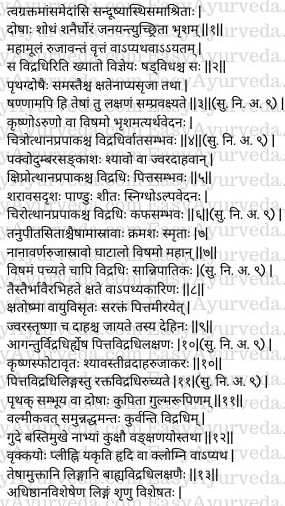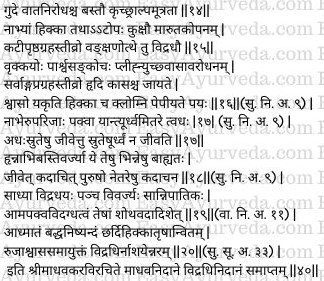Madhava Nidana Chapter 40 Vidradhi Nidanam
This article explains Madava nidana 40th chapter “Vidradhi Nidanam”. Causes, pathology and symptoms of Vidradhi are explained in this chapter.
Read – Acharya Madhavakara: His Work ‘Madhava Nidana’, Legacy, Amazing Facts

Table of Contents
Vidradhi Samprapti, Bheda
Pathogenesis and types of vidradhi
The doshas which have undergone abnormal increase get lodged in the bones and contaminate (bring about abnormal change) skin, blood, muscles and fat gradually (slowly increasing in size) causing localized swelling which is deep seated, painful, round or broad (elongated) in shape. This is known as vidradhi.
This vidradhi is of six types – one from each dosha (vataja, pittaja and kaphaja), one from the combination of all the three doshas (tridoshaja), one from injury (ksataja) and the other one from blood (raktaja). Their features will be described further on. (1-3)
Read – Vidradhi: Causes, Pathogenesis, Types, Treatment, Medicines

Vataja Vidradhi
The vidradhi caused due to increase of vata is black or red (reddish brown) in colour, often increasing or decreasing in size, associated with severe pain, gets manifests and suppurates in many ways (variations are seen in the duration of onset and time of suppuration). (4)
Pittaja Vidradhi
The vidradhi caused due to increase of kapha resembles a big saucer, is pale (yellowish white in colour), cold, unctuous (smooth), associated with mild pain, and is slow in manifesting and suppurating. (6)
Read – Rakta Vidradhi – Abscess After Childbirth: Causes, Symptoms, Treatment
Nature of Pus
Nature of secretions (pus) in the doshaja types of vidradhi
The pus exuding from the above-mentioned types of doshaja vidradhi will be thin, yellow and white respectively i.e.,
thin in vataja,
yellow in pittaja and
white in kaphaja vidradhi.
Sannipataja Vidradhi
Sannipaatajavidradhi (due to increase of all the three doshas) will be having different kinds of colours, pain and exudation, with elevated sprout, unsteady in nature, very troublesome and with irregular time of suppuration.(7)
Read – Classification Of Pain And Arthritis As Per Ayurveda
Agantuja Vidradhi
In persons who are subjected to injury by canes (baton), stones etc. (and other weapons) and also get indulged in unwholesome foods, the heat of the wound being stimulated by vata will also vitiate the blood and pitta. The vidradhi formed as a result of this is called as agantuja vidradhi (abscess caused by external agents / injury). In this condition the person will have fever, thirst and burning sensation. The other symptoms of pittaja vidradhi are also seen in this type of vidradhi. (8-9)
Read – Bad Food Combinations and Solution as Per Ayurveda
Raktaja Vidradhi
In raktaja vidradhi (abscess caused by aggravated blood) the abscess is enveloped on all sides by black coloured eruptions (boils, blisters), is of blackish blue in colour, causes severe burning sensation and pain and has other symptoms of pittaja vidradhi. (10)
Antarvidradhi (Internal abscess)
The doshas undergoing abnormal increase due to their etiological factors, either individually or in combination, produce vidradhis inside the body, in different organs, resembling a spreading shrub / bush or anthill. Since these abscesses happen inside the body they are called as antarvidradhi.
Places of the body where antarvidradhi develops – The seats of internal abscess include the rectum, opening of urinary bladder, umbilicus, lower part of the abdomen (abdominal cavity), groins, kidneys, spleen, liver, heart, pancreas or any other place in the body i.e., abscesses can occur in these organs or any other organ which has not been mentioned.
General Symptoms – The general symptoms of internal abscesses are similar to the symptoms of external abscesses. Apart from these, the internal abscesses have special symptoms related to the seat in which they get manifested. They will be described here now. (11-14)
Read – Blisters: Ayuvedic Understanding, Treatment Principles

Symptoms of Antarvidradi
Symptoms based on the organs in which they get manifested
If the abscess is in the rectum, it causes obstruction to movement of the flatus.
If the abscess occurs in the urinary bladder, it would cause difficulty in urination and scanty urination.
The abscess occurring in the umbilicus would cause hiccough and gurgling sounds in the abdomen.
If the abscess occurs in the abdomen, it would cause the symptoms of vata increase like pain, distension of the abdomen etc.
If the abscess happens in the groins, it would cause severe stiffness or gripping (catching) pain in the waist or back.
If the abscess occurs in the kidney, there would be constriction of the flanks.
If the abscess occurs in the spleen, there will be obstruction or difficulty in breathing.
If the abscess is found occurring in the heart (region of the heart), there will be catching pain in all the parts of the body and cough.
If the abscess occurs in the liver it would cause dyspnoea and hiccough.
If the abscess occurs in the pancreas the person would drink large quantities of water often because in this condition there will be severe thirst. (14-16)
Read – Injury, Wound care Ayurvedic Remedies, Medicines
Prognosis of Vidradhi
When the vidradhis occurring above the level of umbilicus (organs placed above the level of umbilicus) burst open, they discharge (expel) their contents through an upward route (mouth). On the other hand, when the vidradhis below the level of the umbilicus (organs below the level of umbilicus) burst open, they discharge their content through a downward route (anus or urinary passage – urethra). (The discharges may be in the form of pus or blood).
When the discharges come out in the downward direction the patient will survive. On the other hand, if the discharges occur from the upward routes he will not survive (will die).
The patient in whom the internal abscess, other than those occurring in the region of the heart, umbilicus and urinary bladder burst open towards outside of the body may sometimes survive. (The abscess occurring in the heart, umbilicus and urinary bladder are incurable). Even if the abscess occurring in the region of the heart, umbilicus and urinary bladder open towards outside of the body, the patient would not survive. (17-18)
Apart from the tridoshaja vidradhi (abscess caused by simultaneous aggravation of all three doshas) the other five kinds of vidradhis are curable. Tridoshaja Vidradhi is incurable. The unripe, ripening and ripened stages of vidradhi are similar to those explained in the context of sotha (inflammatory oedema explained in the next chapter). If the patient of antarvidradhi also has distension of abdomen, obstruction of urination, vomiting, hiccough, thirst, severe pain and difficulty in respiration, the patient will die. (19-20)
Thus ends the chapter on Vidradhi Nidanam in Madhava Nidana text written by Acharya Madhavakara.










